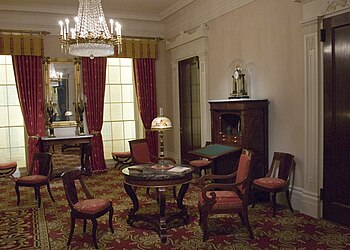Parlour

Parlour (or parlor), comes from the French word parloir, from parler, which means "to speak". The parlour is a room in a house where people could meet. In Turkey it is called a kiosk. The Bible (Judges 3:20), talks about the "summer parlour", a small room built on the roof of the house, with open windows to catch the breeze. It has a door to the outside by which visitors can enter.
In parts of Great Britain and the United States, parlour is a common name for certain types of restaurants such as "ice cream parlour" and "pizza parlour". There are also "Beer parlors",[1] wine parlors,[2] or, in at least one case, a "spaghetti parlor."[3] The word parlour has even been used to describe a coffee shop as the "coffee parlor."[4] It can also mean a special service business, such as a tattoo parlour.
The "inner parlours" in 1 Chronicles 28:11 in the Bible were the small rooms or chambers which Solomon built all round two sides and one end of the Temple (1 Kings 6:5). Some people think the inner parlours may have been the porch and the holy place.
In medieval Christian usage, the parlour was one of two rooms in a monastery. The 'outer parlour' was the room where the monks or nuns could meet a visitor and do business with people from outside the monastery. It was generally in the west range of the buildings of the cloister, close to the main entrance. The 'inner parlour' was found off the cloister, next to the chapter house in the east range of the monastery. Most religious orders wanted silence in the cloister, which was the place where the monks studied. The inner parlour was a place where the monks could talk without disturbing the others in the cloister.
In modern use, the parlour is a formal sitting room in a large house or mansion. In the late 19th century, it was often a formal room used only on Sundays or special occasions, and closed during the week. The family kept their best furniture, works of art and other things on display in the parlour. The body of someone who died would be put on show in the parlour while funeral was being organized. During the 20th century, architects and decorators have changed the use of the room. In most homes the parlour has been replaced by the living room.
References[change | change source]
- ↑ Kroetsch, Robert (1998). What the Crow Said. University of Alberta. p. 100. ISBN 978-0-88864-303-2.
- ↑ "The Wine Parlor at St Francisville - Home". Archived from the original on 2009-09-24. Retrieved 2009-10-09.
- ↑ McLean, Maria Coletta (2004). Mamma Mia!: Good Italian Girls Talk Back. ECW Press. p. 181. ISBN 978-1-55022-651-5.
- ↑ "Archived copy". Archived from the original on 2017-09-11. Retrieved 2021-01-24.
{{cite web}}: CS1 maint: archived copy as title (link)
Other websites[change | change source]
- Victorian Parlour, Archived 2009-03-04 at the Wayback Machine Oxford, Ohio
- Interior of Mt. Auburn, Cincinnati parlour in 1886 Archived 2009-03-04 at the Wayback Machine
